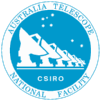| Version 1 (modified by , 17 years ago) (diff) |
|---|
Explanation of Development Stages
Schedule groups the development work into distinct stages. This page gives more background on each of those.
- We plan to start with simulated CABB output files, which should be available by 2007 Oct. Many of the CABB output formats have been written already, by various observatory systems (MOPS, Parkes DFBs) using the ATNF's standard RPFITS library; the changes to Miriad mainly relate to handling the larger number of IFs and spectral channels within the data files. Shortly after the first test data starts appearing (Nov 2007) it will be possible to read it into Miriad and do basic processing of subsections of the full bandwidth. At this stage interactive review and flagging of the UV data will be necessary. Some changes to the data selection subroutines and the INVERT task may be needed before images can be formed.
- The next phase is to create scripts that will process the entire bandwidth in sections, relieving users of a lot of book-keeping. This will be ready when CABB stage 1 is complete (Apr 2008). These scripts could trivially be made to process the data for the separate frequency bands in parallel and thus make good use of multi-processor machines or clusters. Forming continuum images by summing deconvolved images of the subsections will somewhat limit the quality that can be achieved.
- The zoom bands are subsections of wide bands, and thus can make use of the calibration derived for their "parent" wide band. Cross-calibration procedures for the zoom bands will be developed and tested towards the end of the commissioning period. This work should be relatively straightforward but provides a distinct chunk of functionality, so we have shown as a distinct stage.
- The large number of channels in CABB data and the large data volume will make automated flagging highly desirable, possibly essential. The next stage of work focuses on this area. New heuristics will be needed to remove RFI sources similar to the 128MHz "birdie" that affects current data, and make use of new "bad data" indicator flags in the CABB data files. This work will start as soon as our Stage 1 code is released (Mar 2008) and continue through the early part of the commissioning period (Apr-Jul 2008). Work on new flagging methods employing the auto-correlation data will be pursued in this period as well. Some further work in this area (using data from dedicated RFI monitoring antennae) may be required when the new 1-3GHz receivers are installed (Mar 2009).
- The existing miriad code is adequate for handling data with up to 30% fractional bandwidth. The CurrentBandwidths table shows that there will be no requirement to handle larger fractional bandwidths until well into 2009. Accordingly we have scheduled the work on handling large fractional bandwidths in the later stages; Stage 5 and 6 will start in the second half of 2008 and continue until the last quarter of 2009. Some of the work in stage 6 should continue after the project close and then form part of regular Miriad maintenance and improvement.
- Push MFS off to this stage.
